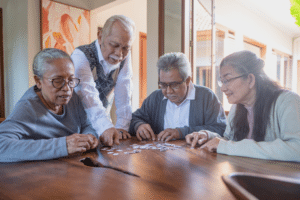Too often when we talk about the disabled population, we focus on what they can’t do. But much more important is what they can do, and that list of possibilities grows all the time as new technologies reverse impossibilities and courageous people blaze new trails. But for those people with disabilities who are not connected to the many opportunities or who lack the confidence to dive in, life can be isolating and limiting.
Ed Gallagher’s advice from firsthand experience? Don’t just play it safe. Get active. It would be a mistake to assume there aren’t ways and opportunities to be active, have fun, and feel a resilient sense of purpose, regardless of the nature of your disabilities.
Gallagher is blind and mostly deaf. He is also an integral member of the Bay Area Association of Disabled Sailors (BAADS), an organization that teaches sailing to individuals with diverse abilities and disabilities. Recently, I sat down with Gallagher to learn more about how the organization has created a community around this innovative water sport, one of the many inspiring things to do in San Francisco for people with disabilities.
What Is the Bay Area Association of Sailors with Disabilities?
BAADs started out as a one-boat program about 30 years ago on Lake Merritt in Oakland. Today, it is a 40-boat force on the San Francisco Bay, committed to challenging the boundaries that stand between disabled people and an active, full life. Gallagher explains, “That’s what we emphasize in BAADS: for people to extend their possibilities and push everything to the limit. Because it’s the only way you learn, and it’s so easy to become complacent.” BAADS, he says, is a teaching school, and students with mental, physical, and developmental disabilities are out on the Bay every weekend learning how to sail. The water of the San Francisco Bay is challenging to ride and to navigate, but BAADS is committed to instilling confidence in even brand-new sailors. “They say, if you can sail in San Francisco, you can sail in any place in the world,” Gallagher adds.
At BAADS, students begin by learning the fundamentals of sailing in a classroom on the ground and then get comfortable in a boat designed with assistive technology to gain experience on the Bay. Some students have never sailed before. Some have never even been in a boat. Others were sailing their whole lives before disability set in, and they are having to learn new skills and make use of new technologies in order to set sail once again.
Gallagher, for example, developed a love of sailing very early in life and was an avid sailor until he lost his vision. He thought this incredible passion was lost until the Department of Veterans Affairs (the VA) helped connect him with BAADS, and he started experimenting with camera technology, enlisting a friend who was remotely watching through the camera to be his eyes. With the camera attached to Gallagher’s bicycle helmet, his ally on the ground was able to tell him, “Do this. Go that way. Watch out for this.” Gallagher learned how to sail in a whole new way and now teaches and empowers others to take that leap and discover what they’re really capable of. “With the advent of new technology,” he reflects, “people all over the world are able to function on par with their able-bodied counterparts.”
BAADS is now one of the largest sailing schools for people with disabilities in the country. Whether you are paraplegic, quadriplegic, blind, have no arms or legs, there is a space in a boat for you. One of the biggest advantages that comes out of this program is that participants develop greater confidence in themselves, their abilities, and their community by being immersed in a supportive environment where they can feel a sense of belonging and purpose. Another powerful advantage is that participants learn effective communication skills, especially as they are interacting with people of varying abilities and discovering creative ways to relate to each other while navigating sailboats on the water. This experience also connects participants with the natural environment, which can be an important influence if they have previously been isolated and experiencing only the limitations of home. With BAADS, Gallagher found a community he wanted to be involved with that reversed the experience of isolation that is so common among people with disabilities. He was able to reconnect with his original passion for sailing in a new way, as well as to become a teacher and a leader guiding others to discover their own interest and passion.
Taking Advantage of the Best Things to Do in San Francisco for Disabled People
Sometimes, all it takes to wake up your passion for life is to find an activity that draws you out of your comfort zone. Gallagher remembers one young woman who lives across the street from the yacht club where BAADS is based. She was passing by in her wheelchair one day when members were holding a meeting. When they noticed her, they asked if she was looking for BAADS, but she had never heard of it. She discovered the opportunity entirely by accident.
Born with no arms or legs, she had put herself through law school and achieved incredible feats in that area but had never been on a boat before. She went through the BAADS training there at the marina, learning how to sail with the motion of her head. She now sails competitively and has served in leadership positions in the organization. “She just blossomed!” Gallagher remembers, and he explains that her whole family recognized the evolution that took place with this new passion that calls her to stretch beyond her seeming limitations and become an active member of the San Francisco sailing community.
Learning to sail, particularly with disabilities, is a great journey into the unknown. The self-confidence and other diverse skills that people pick up tend to transform all aspects of their lives. Opening up to this experience encourages participants to open up more and more to life in general. When you experience a disability, you may need to rely more on others and put greater trust in technology. It’s not easy to do—to extend that willing trust—but if you can, a whole world of opportunities appears.
Activities for disabled people, such as sailing with BAADS, can help you to develop that trust in yourself and the world around you and to say “yes” to really living. Gallagher insists that persistence is the key to unlocking opportunities: “With perseverance, you just don’t give up; you don’t quit,” he says. “Edison had made three thousand different light bulbs before he got one that worked. And that’s persistence.” New technologies and supportive communities will continue to create opportunities for people with disabilities, and those people will have the choice to say “yes” and expand their horizons, despite the challenges.
Just as there are ways to feel more connected and active in the community, there are ways to improve life and independence at home. At Institute on Aging, we’re committed to offering programs, services, and resources for individuals with disabilities, their caregivers, and their families, opening the door to a more graceful, grounded, and fulfilling life. Contact us today to find out about the personalized opportunities available to you.







